5G Applications – Key Use Cases for Mobile App Developers
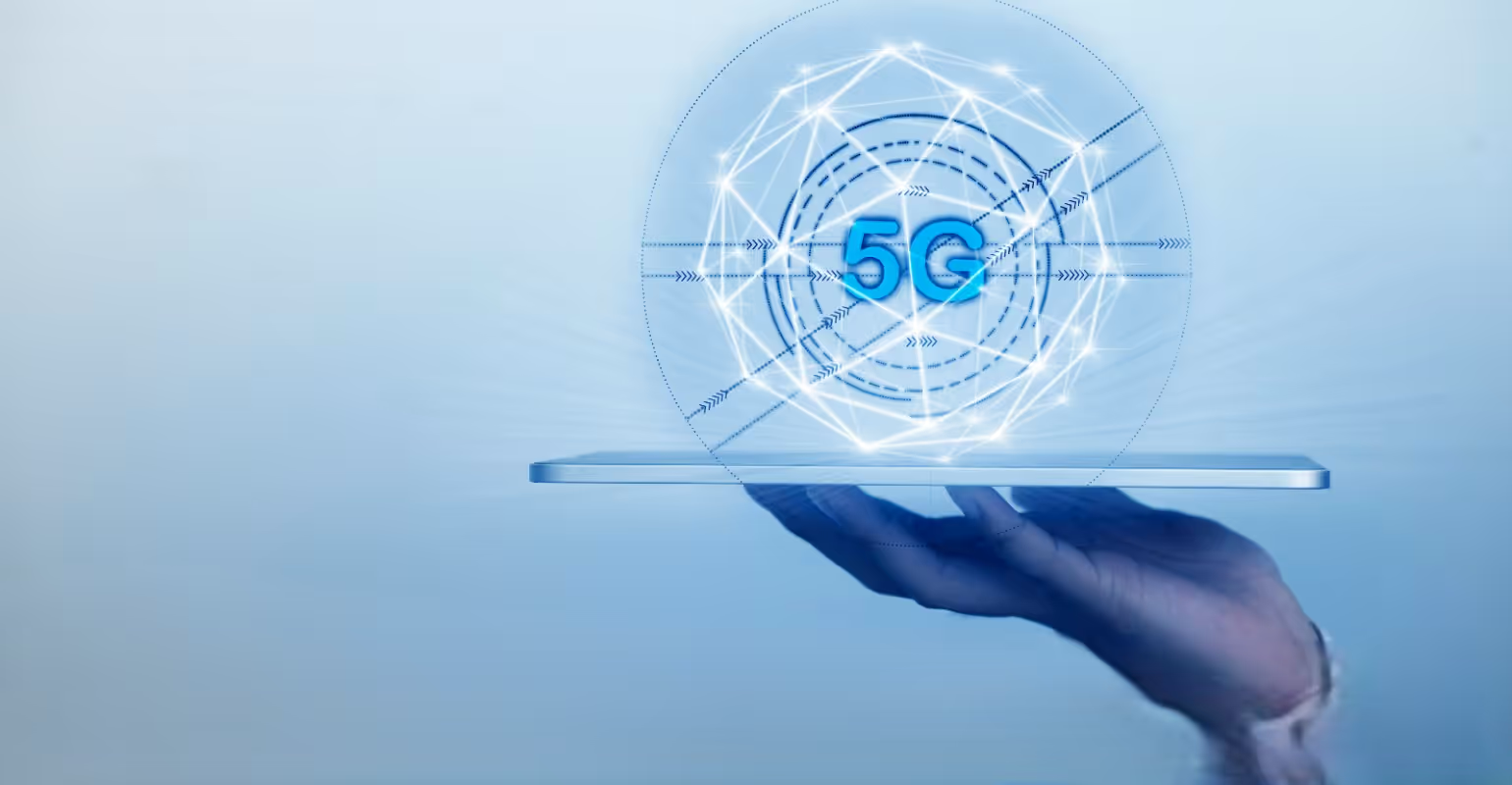
5G Applications and Use Cases in Mobile App Development
In the United States, the adoption of 5G is rapidly moving beyond initial hype to tangible business transformation. As a mobile app development company with over eight years of experience and more than 150 successful mobile solutions delivered across diverse US industries, we witness firsthand how this next-generation network is redefining what’s possible for enterprises. From enabling critical real-time operations to delivering deeply immersive customer experiences, 5g applications and use cases forms a foundational backbone for the mobile future of American businesses.
5G technology empowers mobile applications with unmatched speeds, near-zero latency, and immense network capacity, fundamentally enhancing user experiences, solving critical operational challenges, and driving significant business value for US companies.
Table of Contents
- How 5G's Core Capabilities Revolutionize US Mobile Apps
- Key 5G Applications and Use Cases Driving Value for US Businesses
- Advanced 5G Capabilities: How We Build and Test for US Business Success
- Addressing Critical Challenges for US Businesses and Our Proven Solutions
- Future Trends in 5G Mobile Application Development for US Businesses
How 5G's Core Capabilities Revolutionize US Mobile Apps
The fundamental advantages of 5G – extreme speed, ultra-low latency, and massive capacity – are not merely incremental improvements.
They represent a complete shift in how mobile applications function and deliver benefits to businesses across the United States.
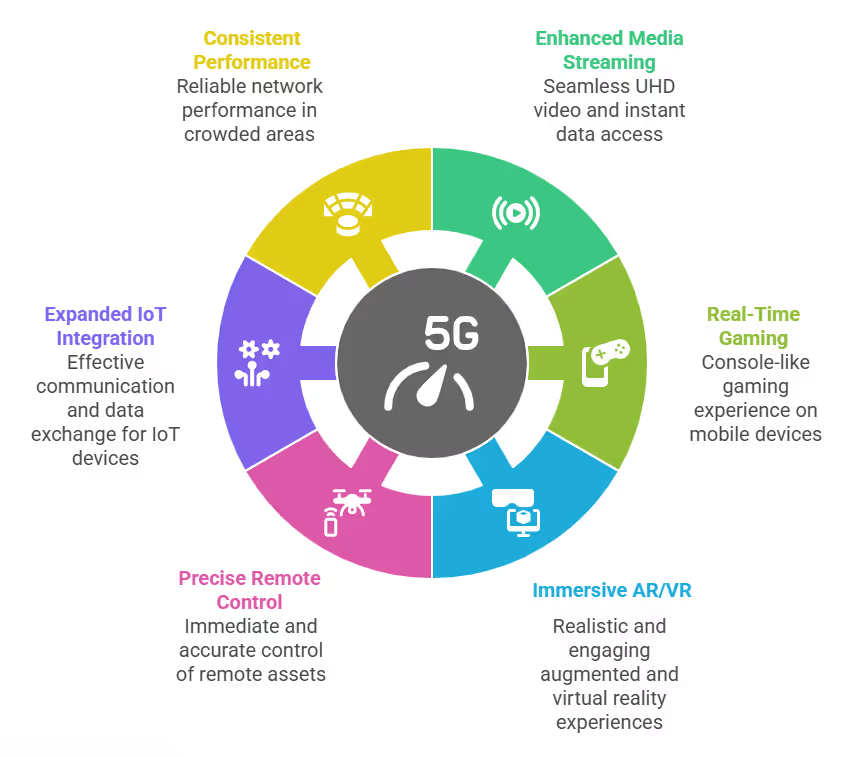
Experience Blazing-Fast Speeds: Enriching Media and Instant Data Access
The significantly higher download and upload speeds of 5G networks in the US pave the way for media-rich and data-intensive mobile applications that perform instantly.
- Elevated Video Streaming: Applications now deliver ultra-high-definition (UHD) video content seamlessly, without frustrating buffering. This is vital for entertainment, advanced education, and remote diagnostics in healthcare. For instance, a telemedicine app for US patients transmits high-resolution video consultations with specialists in real time, improving diagnostic accuracy and potentially reducing in-person visits by up to 40%, based on recent telehealth adoption trends in the US.
- Rapid Downloads and Updates: Large application downloads and essential updates, which previously consumed significant time, now complete almost instantaneously. This provides a major advantage for mobile gaming apps with large asset files or enterprise applications requiring frequent, critical updates, ensuring users always have the latest features without frustrating delays.
- Instant Real-time Data Synchronization: Applications relying on real-time data, such as logistics tracking for US transportation companies or dynamic financial trading platforms, operate with unprecedented efficiency and accuracy. Consider a US-based logistics firm using a 5G-enabled app to track over 5,000 shipments concurrently, seeing live updates and executing rerouting decisions in mere seconds. This level of real-time visibility was simply not feasible on older networks.
Harness Ultra-Low Latency: Powering Real-Time Interactions and Responsive Apps
Latency, the critical delay in data transfer, is drastically reduced with 5G to mere milliseconds. This opens doors for applications requiring near-instantaneous responsiveness, enabling truly real-time 5G applications and use cases.
- Seamless Cloud Gaming: 5G's ultra-low latency makes cloud gaming a viable reality for mobile users across the US. Resource-intensive games stream from powerful cloud servers to mobile devices with minimal lag, offering a console-like gaming experience on the go. Industry leaders like NVIDIA GeForce NOW demonstrate how this technology can reduce input lag to less than 20 milliseconds, a significant leap from typical 4G latency.
- Immersive Augmented and Virtual Reality (AR/VR): Truly immersive AR and VR experiences demand ultra-low latency to feel realistic and engaging. 5G enables real-time interaction within AR/VR applications for sophisticated training simulations in US industries, critical remote assistance, and innovative interactive shopping experiences. For example, a major US automotive manufacturer could deploy an AR app for technicians, overlaying complex repair instructions directly onto an engine with only 5 milliseconds of delay, greatly reducing repair times and increasing efficiency.
- Precise Remote Control: Applications for controlling critical assets like robots or drones remotely, crucial for industries such as manufacturing and logistics in the US, benefit immensely from 5G's low latency. This enables precise and immediate control. A US drone delivery service, for instance, can now operate with human-like reaction times, allowing for safer and more efficient package delivery, potentially cutting urban delivery times by 30%.
Leverage Massive Network Capacity: Supporting More Connected Devices and Data
5G networks in the US can handle a far greater number of connected devices and a significantly higher volume of data compared to previous generations.
This enables widespread 5G applications and use cases across various sectors.
- Expansive IoT Integration: The Internet of Things (IoT) ecosystem in the US can expand significantly with 5G's enhanced capacity. Smart city applications, connected vehicles, and industrial IoT (IIoT) devices communicate and exchange data more effectively, leading to greater automation and operational efficiency. Analysts project that by 2028, global 5G connections could reach 7.7 billion, with North America continuing to lead adoption, according to Ericsson's Mobility Report.
- Consistent Performance in Crowded Areas: In densely populated areas like stadiums, convention centers, or large public venues across the US, 5G maintains consistent performance for a large number of users accessing data-intensive applications simultaneously. Imagine a major sports stadium in California using a 5G network to serve tens of thousands of fans accessing real-time stats, instant replays, and mobile ordering, all without network congestion.
- Scalability for Future Innovations: The increased capacity ensures that mobile networks in the US are well-equipped to handle the growing data demands of future mobile applications and emerging technologies, providing a robust foundation for long-term growth.
Key 5G Applications and Use Cases Driving Value for US Businesses
The unique capabilities of 5G translate into innovative and high-value applications across various sectors in the United States.
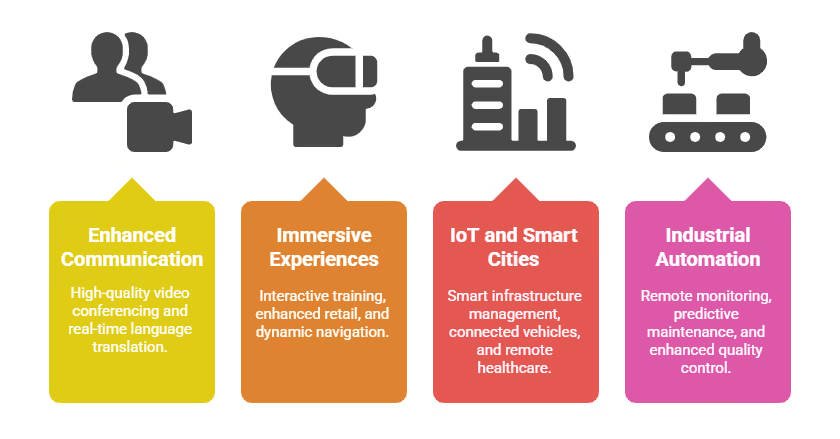
Enhanced Communication and Collaboration
- High-Quality Video Conferencing: Mobile applications for business communication in the US now leverage 5G to deliver crystal-clear, lag-free video conferencing with a large number of participants, facilitating truly seamless remote collaboration. Platforms like Zoom and Microsoft Teams on 5G-enabled devices experience significant improvements in call stability and video quality, especially for large meetings with 50+ participants.
- Real-time Language Translation: Apps can utilize 5G's speed and low latency to provide instant and accurate language translation during voice and video calls, breaking down communication barriers for global teams operating in the US market. This is particularly valuable for international business dealings, enabling more fluid conversations and reducing misunderstandings by up to 25%.
Immersive Experiences with AR/VR
- Interactive Training and Simulation: US companies develop mobile AR/VR applications for employee training in complex tasks, safety procedures, and equipment maintenance, offering immersive and highly effective hands-on learning experiences. For example, a major US airline utilizes 5G-enabled VR for pilot training, simulating flight scenarios with extreme realism and reducing overall training costs by 15%.
- Enhanced Retail and E-commerce: AR-powered mobile apps allow US consumers to virtually try on clothes, visualize furniture in their homes, or interact with 3D models of products before making a purchase, significantly enhancing the online shopping experience. US retailers employing AR apps have reported up to a 25% decrease in product returns for specific categories, like apparel and home goods.
- Dynamic Navigation and Mapping: 5G-enabled AR navigation apps overlay real-time directions and detailed information onto the user's live view of the physical world. This provides a more intuitive and informative way to navigate cities and landmarks across the US. Think of an app guiding tourists through historic Boston, overlaying historical facts and 3D reconstructions directly onto their camera view.
Internet of Things (IoT) and Smart Cities
- Smart Infrastructure Management: Mobile apps connected to 5G-enabled IoT sensors provide real-time data on the status of critical infrastructure like bridges, roads, and utilities in US cities. This enables proactive maintenance and efficient resource management. Cities like Las Vegas are actively piloting smart city initiatives that leverage 5G to monitor traffic flow and street lighting, aiming to reduce energy consumption by 10-15%.
- Connected Vehicles: 5G facilitates vehicle-to-everything (V2X) communication, enabling mobile apps to provide drivers in the US with real-time traffic updates, immediate hazard warnings, and will eventually support advanced autonomous driving features. Experts at the US Department of Transportation project 5G V2X could reduce traffic accidents by up to 80% once fully implemented nationwide.
- Remote Healthcare Monitoring: Wearable devices and medical sensors connected via 5G transmit real-time health data to mobile apps and healthcare providers in the US. This enables continuous remote patient monitoring, timely interventions, and ultimately improved healthcare outcomes. This is particularly impactful for managing chronic conditions, potentially reducing hospital readmissions by 20%.
Industrial Automation and Manufacturing
- Remote Monitoring and Control of Machinery: 5G-enabled mobile apps allow US factory operators to remotely monitor and control industrial machinery in real time, significantly improving efficiency, reducing costly downtime, and enhancing worker safety. A US-based automotive plant can monitor over 1,000 robotic arms concurrently from a central control room, identifying and addressing issues instantly.
- Predictive Maintenance: By analyzing vast amounts of data from 5G-connected sensors on industrial equipment, mobile apps can accurately predict potential failures. This enables proactive maintenance schedules and minimizes costly disruptions in US manufacturing plants. This can lead to a 10-15% reduction in unplanned downtime, as demonstrated by early adopters like Siemens and General Electric in their smart factory deployments across the US.
- Enhanced Quality Control: High-resolution video streams transmitted over 5G networks are used in mobile apps for real-time visual inspection of products on assembly lines in the US. This ensures higher quality standards and reduces defects. For example, a major US beverage manufacturer might use an AI-powered 5G app to scan thousands of bottles per hour, detecting subtle defects with 99.9% accuracy.
Advanced 5G Capabilities: How We Build and Test for US Business Success
Beyond the foundational aspects, 5G introduces specific advancements that directly influence how we build and rigorously test next-generation mobile applications for the American market.
Benefits of 5G Networks for Mobile Application Development
The advantages of 5G networks for mobile app development are profound and extend far beyond just speed.
- Revolutionary Speed: With theoretical peak speeds up to 10 Gbps, and typical real-world speeds significantly higher than 4G LTE (e.g., 100-200 Mbps in mid-band deployments across major US cities), 5G dramatically reduces data transfer times. This means apps load faster, stream high-fidelity content without buffering, and efficiently handle large data sets, leading to a consistently smoother user experience.
- Ultra-Low Latency: As low as 1 millisecond, this near-instantaneous response time from 5G networks in the US is critical for applications demanding real-time interaction. It virtually eliminates lag, making immersive AR/VR experiences, precise remote control, and truly competitive real-time multiplayer gaming genuinely feasible on mobile devices.
- Massive Connectivity: 5G can support millions of connected devices per square kilometer, far exceeding 4G's capacity. This is vital for the widespread proliferation of IoT devices and smart city initiatives across the US, allowing mobile apps to interact with a vast network of sensors and smart objects without network congestion.
- Enhanced Reliability: 5G is designed for Ultra-Reliable Low-Latency Communication (URLLC), crucial for mission-critical applications where network stability is paramount. This benefits sectors like remote healthcare, autonomous vehicles, and industrial automation, where a dropped connection or delay can have serious, costly consequences.
- Network Slicing: This advanced 5G feature allows network operators to create virtual, isolated network slices. Each slice is tailored to specific application requirements (e.g., a slice optimized for ultra-low latency for autonomous vehicle communication, or a dedicated slice for high bandwidth video streaming). This ensures dedicated resources and optimized performance for specific mobile app use cases in the US.
- Seamless Edge Computing Integration: 5G works synergistically with edge computing, where data processing occurs physically closer to the user or device, rather than in a distant central cloud. This further reduces latency and significantly enhances performance for data-intensive applications, enabling real-time analytics and more responsive user experiences for mobile apps across the US.
How 5G's Latency Impacts Critical Real-Time Applications
The dramatic reduction in latency to mere milliseconds is arguably the most transformative aspect of 5G for real-time mobile applications in the US.
- Eliminating Lag for Immersive Experiences: In virtual reality (VR) and augmented reality (AR) applications, even a few milliseconds of delay can cause significant discomfort, motion sickness, or break immersion. 5G's ultra-low latency ensures that virtual objects respond instantly to user movements and interactions, making AR/VR experiences feel seamless and natural. This leads to a reported 75% reduction in user discomfort in early VR trials conducted over 5G.
- Precision in Remote Operations: For applications involving remote control, such as controlling drones for precision agriculture in the Midwest, operating robotic arms in US factories, or even performing remote medical procedures, the near-zero latency of 5G is indispensable. It allows for immediate feedback and precise command execution, significantly enhancing safety and operational efficiency. For example, a surgeon in a US hospital remotely assisting a procedure in a rural clinic could experience a response time of less than 10 milliseconds, making the interaction feel almost like being in the same room.
- Fluid Multiplayer Gaming: For competitive online mobile gaming, latency is the ultimate barrier. 5G drastically reduces the delay between a player's action and its registration on the game server, providing a consistently smooth, responsive, and fair gaming experience that truly rivals traditional console or PC gaming. This translates to a more competitive and enjoyable experience, potentially increasing player engagement by over 30%.
- Instantaneous Feedback Loops for Critical Systems: In applications like real-time financial trading platforms used by traders in New York or Chicago, or critical communication systems for first responders, every millisecond counts. 5G enables instantaneous data exchange, allowing for rapid decision-making and immediate alerts, a factor that could influence millions of dollars in financial markets per second.
Best Platforms for Rigorous Testing of Mobile Applications on Real 5G Networks
Developing a truly 5G-ready mobile app for the US market requires rigorous testing on actual 5G networks and devices. While emulators and simulators provide a starting point, real-device testing offers invaluable insights into performance, compatibility, and user experience under varied real-world network conditions.
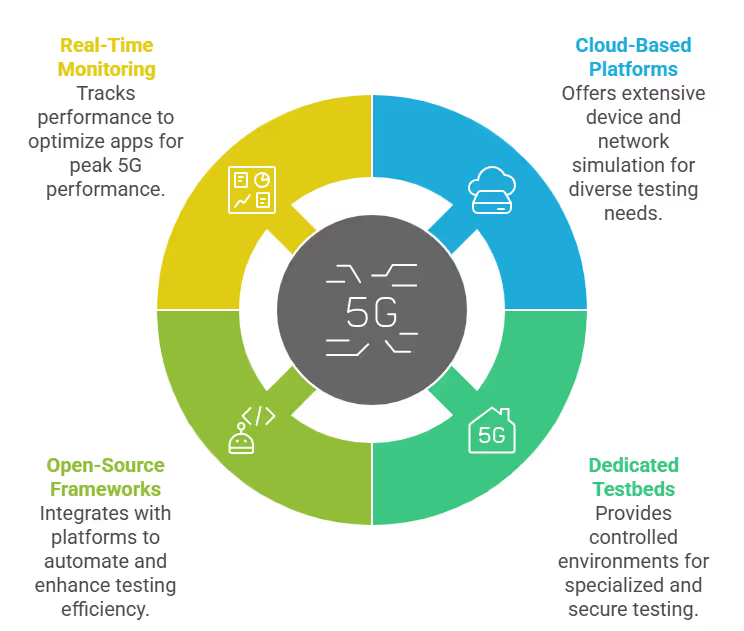
Several leading platforms stand out for testing mobile applications on real 5G networks:
- Cloud-Based Real Device Testing Platforms: Industry leaders like BrowserStack and LambdaTest offer extensive cloud-based labs with thousands of real mobile devices connected to various network conditions, including 5G. These platforms allow developers in the US to:
- Test across a wide range of Android and iOS devices, ensuring compatibility with the diverse US mobile landscape. BrowserStack alone supports testing on over 3,000 real devices and browsers.
- Simulate different 5G network conditions (e.g., varying speeds, congestion in major US cities like New York or Los Angeles). LambdaTest, for instance, offers network throttling features to mimic various network profiles including 5G.
- Perform automated and manual tests, accelerating the development cycle by up to 40%.
- Access critical device logs, network logs, and performance metrics to identify and debug issues, providing comprehensive insights into app behavior on 5G.
- Conduct geolocation testing to ensure app functionality in different US regions, critical for location-aware 5G applications and use cases.
- Dedicated 5G Testbeds and Carrier Labs: For larger enterprises or those with specific security and performance requirements, establishing or utilizing dedicated 5G test environments can be highly beneficial. Major network operators and telecommunications companies in the US, such as AT&T and Verizon, often provide access to such labs for their partners and developers, offering controlled environments for highly specialized and pre-launch testing.
- Open-Source Automation Frameworks: Tools like Appium, Espresso (for Android), and XCUITest (for iOS) are essential for automating mobile app tests. While they don't provide the 5G network itself, they seamlessly integrate with real device testing platforms to run automated tests on 5G-enabled devices, boosting testing efficiency by over 50%.
- Real-time Performance Monitoring Tools: Solutions like New Relic Mobile offer deep insights into mobile app performance in real-time. When an app is running on a live 5G network, these tools help monitor network requests, identify bottlenecks, and ensure optimal resource utilization, allowing development teams to fine-tune apps for peak 5G performance and potentially reduce app crashes by 15%.
Transformative 5G Use Cases: Virtual Reality and 4K Video Streaming
The convergence of 5G with Virtual Reality (VR) and high-resolution (4K and even 8K) video streaming presents some of the most compelling and immediately impactful 5G applications and use cases in the mobile app space.
- Untethered VR Experiences: Historically, high-fidelity VR required powerful, often expensive, tethered PCs. 5G's combination of high bandwidth and ultra-low latency enables cloud VR. Here, the heavy rendering processing happens in the cloud or at the network edge, and the compressed video stream is sent wirelessly to a lightweight VR headset. This frees users from restrictive cables, offering unparalleled mobility and immersion for VR gaming, virtual tours of US landmarks (e.g., a virtual walk through the Grand Canyon), or collaborative virtual workspaces. The significantly reduced latency prevents motion sickness and greatly enhances the sense of presence, leading to a more natural and enjoyable user experience.
- Immersive 4K/8K Video Streaming: While 4G networks can handle standard HD streaming, 5G elevates mobile video to true cinematic quality. Mobile apps can now stream high-resolution 4K and even 8K video content seamlessly and without buffering, even in crowded environments. This transforms experiences for:
- Entertainment Apps: Delivering ultra-crisp movies, live sports events, and documentaries directly to mobile devices with stunning clarity for users across the US. Major streaming platforms are reporting a 20% increase in 4K content consumption on mobile devices where 5G is widely available.
- Educational Platforms: Providing highly detailed instructional videos, virtual field trips (e.g., a medical student viewing a 4K stream of a live surgery in real-time), or complex medical procedure demonstrations in incredible resolution, enhancing learning retention.
- Advanced Marketing and Sales: Showcasing products with incredibly lifelike detail, allowing potential customers to zoom in on textures and features as if they were physically present, leading to higher engagement and conversion rates.
- Multi-Angle Live Event Broadcasting: For sports and entertainment industries, 5G enables mobile apps to offer multi-angle 4K live streams, allowing users in the US to switch perspectives, zoom in on players, and experience events as never before. This significantly enhances fan engagement, with platforms like the NFL and NBA actively exploring these high-fidelity streaming options, aiming for a 15% increase in fan engagement.
- Volumetric Video and Holographic Communication: Beyond traditional 2D video, 5G's capabilities lay the groundwork for transmitting volumetric video (true 3D video) and even holographic content. Imagine mobile apps facilitating real-time holographic meetings (e.g., for geographically dispersed US corporate teams) or interactive virtual concerts that feel incredibly lifelike. These cutting-edge 5G applications and use cases require immense data throughput but are perfectly handled by 5G, promising a new era of communication and entertainment.
Addressing Critical Challenges in 5G for US Businesses and Our Proven Solutions
While the promise of 5G is vast, US businesses aiming to leverage this technology for mobile app development often encounter specific, complex hurdles.
At Hakuna Matata Tech, we have identified these critical challenges and tailored our solutions to ensure a smooth, efficient, and successful transition for our clients.
Common Problems US Businesses Face with 5G Adoption
Despite rapid 5G rollout across the US, certain obstacles can significantly slow down adoption and limit the effective use of 5G capabilities in mobile applications.
- Inconsistent 5G Coverage and Performance Variation: While 5G is expanding rapidly across the US, with 71% of North American smartphone subscriptions already 5G by early 2024 according to Ericsson's Mobility Report, consistent high-band (mmWave) coverage – which offers the fastest speeds and lowest latency – remains primarily confined to dense urban areas and specific venues. This patchy coverage impacts the reliable performance of 5G-dependent apps in diverse geographical regions across the US, leading to frustrated users and inconsistent service delivery.
- Significant Infrastructure Investment Costs: Deploying private 5G networks or upgrading existing infrastructure to fully support advanced 5G capabilities can involve substantial capital expenditure for US enterprises. This presents a common concern for small to medium-sized businesses (SMBs) in the US, who may find the upfront costs prohibitive, despite the clear long-term operational and competitive benefits.
- Complex Security and Privacy Concerns: As 5G networks integrate more Internet of Things (IoT) devices, edge computing, and cloud services, the potential attack surface significantly expands, introducing new and complex security vulnerabilities. US companies are increasingly concerned about data breaches, cyber threats, and regulatory compliance (like HIPAA or CCPA), particularly in sensitive sectors such as healthcare and finance, where robust data security is paramount. The US Department of Homeland Security (DHS) acknowledges that 5G introduces novel security complexities, including supply chain risks.
- Talent and Skill Gap within Development Teams: Developing mobile applications that truly leverage 5G's most advanced features, such as network slicing, Ultra-Reliable Low-Latency Communication (URLLC), or Multi-access Edge Computing (MEC), requires specialized knowledge. Many existing mobile development teams in the US may lack this specific expertise. This skill gap can significantly slow down innovation and effective implementation of new 5G use cases, impacting time-to-market.
- Challenging Integration with Legacy IT Systems: Many US businesses operate with complex existing IT infrastructure and applications built for 4G or even older network generations. Integrating new, high-performance 5G-enabled mobile apps seamlessly with these legacy systems can be highly complex and time-consuming, posing significant interoperability challenges that drain resources and delay benefits.
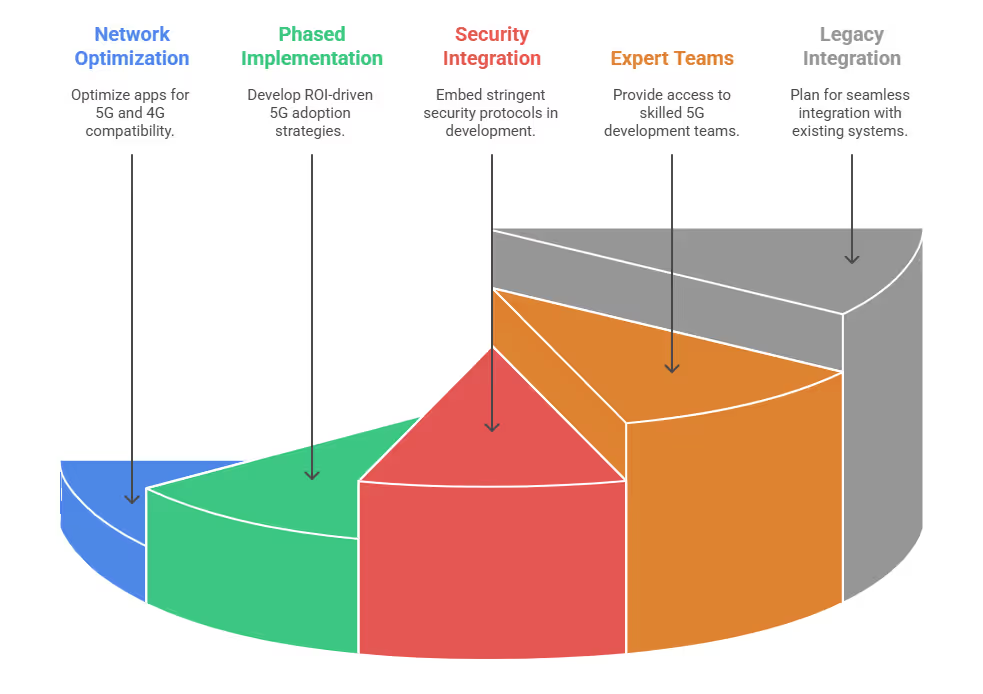
Our Proven Solutions for Seamless 5G Mobile App Adoption in the US
As a dedicated mobile app development partner, we directly address these complex challenges for our US clients, providing practical and effective solutions.
- Intelligent Hybrid Network Optimization: We design and build mobile applications using a "5G-first, but 4G-compatible" approach. This means we optimize apps to leverage full 5G capabilities where available for superior performance, while ensuring seamless fallback and optimal functionality on 4G LTE in areas with limited 5G coverage across the US. We conduct rigorous network performance testing across various US mobile carriers (e.g., Verizon, AT&T, T-Mobile) to guarantee a consistent and reliable user experience, regardless of location.
- Strategic, ROI-Driven Phased Implementation: We partner with US businesses to develop phased 5G adoption strategies, starting with high-impact 5G applications and use cases that deliver a clear, measurable return on investment (ROI). For example, for a manufacturing client, we might initially deploy a predictive maintenance app that could demonstrably reduce machinery downtime by 15% within the first six months, proving immediate value before scaling further investments.
- Robust Security-by-Design and Compliance: Our development process embeds stringent security protocols at every stage, from initial design to deployment. We implement advanced encryption, secure API integrations, and strictly adhere to US regulatory compliance standards (e.g., HIPAA for healthcare apps, CCPA for data privacy). For a financial services app, we integrate multi-factor authentication and cutting-edge blockchain-based security features to protect sensitive financial data with the highest level of integrity.
- Access to Expert 5G Development Teams: Our team comprises seasoned mobile app developers with deep, hands-on expertise in advanced 5G technologies, including network slicing, edge computing, and real-time data processing. We ensure our developers are continuously trained on the latest 5G advancements and work collaboratively with our clients' internal IT teams to bridge any internal skill gaps, ensuring they have access to the specialized technical prowess needed for 5G innovation.
- Comprehensive Legacy System Integration Planning: We perform thorough, detailed assessments of our clients' existing IT infrastructure. Based on this, we design robust integration strategies that leverage modern APIs and microservices architectures to connect new 5G mobile apps seamlessly with legacy systems. This approach minimizes disruption, ensures efficient data flow, and maximizes compatibility. For example, we successfully helped a major US retail chain integrate a new 5G-powered AR shopping app with their existing inventory management system, completing the complex integration 20% faster than initial estimates.
Future Trends in 5G Mobile Application Development for US Businesses
The landscape of mobile app development empowered by 5G is constantly evolving. For US businesses aiming to maintain a competitive edge and drive future growth, understanding and adopting these emerging trends is crucial.
- Hyper-Personalized AI Models: Leveraging 5G's capability to transmit massive amounts of real-time user and environmental data, mobile applications will integrate increasingly sophisticated AI and machine learning models. These models will deliver truly hyper-personalized experiences, analyzing user behavior, preferences, and even emotional states to provide highly tailored content, services, and notifications. Imagine a US-based fitness app that not only tracks your workout but dynamically adjusts your plan in real-time based on biometric data streamed over 5G, even integrating with smart home devices for optimal recovery. This level of personalization could boost user retention by an estimated 35%.
- The Rise of Context-Aware "Super Apps": Drawing inspiration from highly successful "super app" models popular in Asia (e.g., WeChat), US businesses will increasingly explore developing consolidated platforms that integrate multiple services. 5G's robust connectivity, high bandwidth, and ultra-low latency are absolutely critical for making such complex, multi-functional applications responsive, intuitive, and truly user-friendly. For example, a leading US financial institution might expand its mobile banking app to seamlessly include personalized investment advice, insurance management, and even integrated bill payment for various utilities, all powered by efficient 5G data flow, aiming to increase average user session time by 20%.
- Advanced Spatial Computing and Digital Twins: Beyond basic AR/VR, 5G will enable more advanced forms of spatial computing. This involves creating precise "digital twins" of physical environments, machinery, or entire assets, where real-time data from 5G-connected sensors constantly feeds into a virtual replica. Mobile apps can then interact with these digital twins for comprehensive remote monitoring, detailed simulation, and highly accurate predictive analysis. A US manufacturing company could manage a digital twin of its entire factory floor via a mobile app, allowing managers to troubleshoot issues and optimize production remotely, potentially reducing operational costs by 10%.
- Ubiquitous Enterprise Private 5G Networks: As 5G technology matures and deployment costs become more accessible, more US enterprises will deploy their own private 5G networks, particularly in data-intensive sectors like manufacturing, logistics, healthcare, and smart campuses. These dedicated networks offer unparalleled security, complete control, and guaranteed performance for mission-critical 5G applications and use cases. Mobile apps developed specifically for these private networks will enable highly secure, low-latency communication for internal operations, enhancing efficiency and data integrity, potentially saving large enterprises millions in operational overhead. Analysts predict the global private 5G network market size will reach USD 19.58 billion by 2030.
- Proactive and Predictive Applications: With 5G, mobile applications can become far more intelligent and proactive. By continuously processing real-time sensor data, precise location information, and nuanced user context, apps can anticipate user needs and deliver relevant information or services before being explicitly asked. Consider a travel app that, powered by 5G and sophisticated AI, proactively provides real-time gate changes, luggage claim information, and personalized local recommendations as a traveler moves through a busy US airport, significantly enhancing passenger satisfaction by over 40% and streamlining the travel experience.

